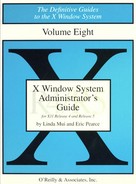Table of Contents
Font Conventions Used in This Book
Chapter 1 An Introduction to X Administration
1.2.4 Maintaining Multiple Machines
1.2.5 A “Philosophy” of X Administration
Chapter 2 The X User Environment
2.2 Components of the X Environment
2.2.2.1 The -fn Command-line Option
2.2.2.2 The -geometry Command-line Option
2.2.3.1 The Foreground Process
2.3.1 Setting the DISPLAY Variable
2.3.1.1 Complications with Display Names
2.3.2 Redefining the Search Path
2.3.2.1 Setting the Search Path for OpenWindows Support
2.3.2.2 Setting the Search Path for Mixed Environments
2.3.3.1 xterm and Terminal Emulation
2.3.3.3 xterm and the Login Shell (C Shell)
2.3.4.1 Starting a Remote Client with rsh
2.4.2 Differences Between .xinitrc and .xsession
Chapter 3 The X Display Manager
3.5.1 The Master Configuration File (xdm-config)
3.5.2 Listing X Servers (the Xservers File)
3.5.3 xdm Host Access Control: the Xaccess File (R5 Only)
3.5.3.1 Direct and Broadcast Access
3.5.3.2 Indirect Access and the Chooser
3.5.3.4 Advantages and Disadvantages of the Chooser
3.5.4.1 Configuring the Login Box
3.5.5 Starting Up Individual X Sessions (the Xsession File)
3.5.5.1 No Home Directory? (R5)
3.6.2 Restarting xdm Using xdm-pid (R4 and Later)
3.6.3 Rereading xdm Configuration Files (R3)
3.7 Permanent Installation of xdm
4.1.3 Problems with Host-based Access Control
4.2 Access Control with MIT-MAGIC-COOKIE-1
4.2.1 Using MIT-MAGIC-COOKIE-1 with xdm
4.2.3 Using MIT-MAGIC-COOKIE-1 with xinit
4.3 The XDM-AUTHORIZATION-1 Mechanism (R5)
4.4 The SUN-DES-1 Mechanism (R5)
4.4.2 Prerequisites for Using SUN-DES-1
4.4.3 Using SUN-DES-1 with xdm
4.4.4 Using SUN-DES-1 with xinit
4.4.5 Adding Another User with SUN-DES-1
4.4.7 Troubleshooting SUN-DES-1
4.6.1 The Console xterm (R4 and Earlier)
4.6.2 The Console and xdm (R5)
4.6.3 Hanging the Server Remotely (R3)
4.6.4 Reading the Framebuffer (Sun Workstations)
5.1 Fonts on the X Window System
5.1.6 The fonts.scale File (R5 only)
5.1.8.1 The FILE_NAMES_ALIAS Alias
5.2.1 Bitmap Versus Outline Fonts
5.3.3 Problems with Running Vendor-specific Clients
5.3.6.2 OpenWindows Conversion
5.3.6.3 Converting from X11/NeWS to PCF or SNF
5.4 Providing Fonts Over the Network
5.5.2 Installing the Font Server
5.5.2.2 Changing BSD Boot Files
5.5.2.3 Changing System V Boot Files
5.5.2.4 Changing AIX Boot Files
5.5.4 Debugging the Font Server
5.5.6 The Font Path and the Font Server
6.1 Color Specification in Release 4 and Earlier
6.1.3 Adding Your Own Color Names (RGB)
6.1.4 Fixing a Corrupted Color Database
6.2 Color Specification in Release 5 (Xcms)
6.2.2 Adding Your Own Color Names in Xcms
7.1 Buying an X Terminal: What's What
7.3.1 Getting the IP Address Using RARP
7.3.2 Getting Information Using BOOTP
7.3.3 Trivial File Transfer Protocol (TFTP)
7.3.4 Setting Up the Network on the X Terminal
7.3.5.2 Updating the arp Table
7.4.3 Choosing TFTP or NFS for Font Access
7.4.3.1 Reading Fonts Using TFTP
7.4.3.2 Reading Fonts Using NFS
7.5 Configuring for the X Display Manager
7.5.1 Configuring the X Terminal for xdm
7.5.4 Configuring xdm Without XDMCP
7.5.5 Setting Up Server Access Control
7.6 Remote Configuration of X Terminals
7.6.1 Remote Configuration on NCD Terminals
7.6.2 Remote Configuration on Visual Terminals
7.6.3 Remote Configuration on Tektronix Terminals
7.7.1 Increasing the Number of Processes
7.7.2 Increasing the Number of Pseudo-ttys
7.7.3 Increasing the Amount of Swap Space
Chapter 8 Building the X Window System
8.1.1 Should You Use MIT Source?
8.1.2 Types of Vendor-supplied X Distributions
8.1.4 Complete or Client-only Distribution?
8.1.5 Installing Multiple X Releases
8.2.1 Do You Have Enough Disk Space?
8.2.2 Is Your Platform Supported?
8.2.5 Creating a Link Tree (Optional)
8.4.1.1 Changing the tmp Directory Using TMPDIR (Ultrix and HP-UX)
8.4.1.2 Changing the tmp Directory Using -temp (SunOS)
8.4.2 Shared Library Installation (SunOS)
8.4.3.1 NFS Installation Without Root Access
8.4.3.2 Installation Over the Network (rdist)
8.4.4 Installing the termcap or terminfo Definition for xterm
8.5.1 Configuration Parameters
8.5.1.3 The Platform Configuration File (platform.cf)
8.6 Building Programs After X Is Installed
8.7.3.2 Multi-line Macros (@@)
8.7.4 imake Configuration Files
8.7.4.1 A Quick Tour of Files Used by imake
8.7.5 Using imake to Build X11
8.8.1 Undefined Symbols or Functions
8.8.1.2 Missing Function Definitions
8.8.2 Searching for Preprocessor Symbols
Appendix A Useful Things to Know
A.1 The comp.windows.x Newsgroup
A.2.1 Getting Files Using ftpmail
A.3 The xstuff Mail Archive Server
A.5 Making a Filesystem Available via NFS
A.6.1 Adding a Host to /etc/hosts
A.7 Adding an Ethernet Address
A.8 Printing Documentation in the MIT X Distribution
A.9 Converting a Number Into Hexadecimal and Back
A.10 Configuring a Sun as an X terminal
A.11 Using More than One Frame Buffer Under SunOS
Appendix B Compiling Public Domain Software
B.2.1 Getting the xarchie Sources
Appendix C X on Non-UNIX Platforms
C.1.1 Requirements for PC X Servers
C.1.2 Installing and Configuring PC X Servers
C.1.3 Problems Particular to PC X Servers
C.2.1 Macintosh-based X Servers
C.2.2 MacTCP and the Communications Toolbox
Appendix D Resources and Keysym Mappings
D.1.1 Resource Definition Syntax
D.1.1.1 Loose and Tight Bindings
D.1.1.2 The -name Command-line Option
D.1.2 Where Resources Are Defined
D.2 Defining Keys and Button Presses With xmodmap
D.2.1 Using xev to Learn Keysym Mappings
Appendix E The Components of X Products
